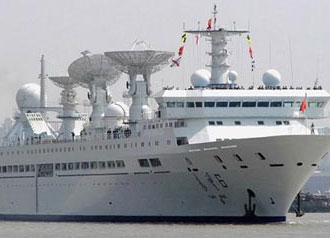China appears to feel that its naval buildup has progressed sufficiently to allow it to retaliate against the US naval presence in the East China Sea by sending surveillance ships to Hawaiian waters.
The People’s Liberation Army Navy (PLAN) electronic reconnaissance ship spotted in Hawaiian waters is most likely of about 4,000-ton displacement and is equipped with various electronic gear for eavesdropping on radio communications and tracking ships and aircraft. It is also believed to have jamming equipment to interfere with the radio communications of other ships.
The ship apparently sailed inside the US 200-nautical mile EEZ (Exclusive Economic Zone) though there is no indication it violated the US 12-nautical mile (13.8-mile) territorial waters defined by the 1982 UN convention on the Law of the Sea. The US has been sending recon ships and planes inside China’s EEZ for decades, but this is the first time that China has acknowledged sending a surveillance ship into the US EEZ.
Under the Law of the Sea, which the US hasn’t ratified but abides by, any nation is free to sail or fly within the EEZ of other nations. Indeed even the 13.8-mile territorial waters can be entered by foreign ships as long as it can be considered “innocent passage”. Sending a military surveillance ship into territorial waters, however, would likely be deemed a provocative act by both the US and China. In the past China has protested incursions into its EEZ by US ships and aircraft but had simply lacked the military muscle to block the incursions or to retaliate with incursions of its own.
The recent deployment of a PLAN surveillance ship into Hawaiian waters is seen as Beijing’s message to the US and the rest of the world that China can now contest the waters of the western Pacific and that the US Navy no longer has a free pass in the region. It is also seen as a form of retaliation for what Beijing considers the provocative naval exercises the US recently conducted in the Yellow Sea jointly with the navies of South Korea and Japan’s Self-Defense Force. China’s three major fleets are currently also conducting the Mobile 5 naval exercise in undisclosed western Pacific waters.
In the parlance of PLA military strategists the Hawaiian islands are considered the center of the “third island chain” extending from Alaska’s Aleutian Islands to Australia and demarks the “strategic rear” of the US Asia-Pacific military forces. Being only about 2,400 miles from San Francisco, the crossing of the third island chain by PLAN would represent a potential for offensive actions against the US by the Chinese military — Beijing’s perspective, roughly analogous to the regular encroachments by the US navy across the second island chain which is deemed to stretch from Japan to Indonesia.
Even more disconcerting to China’s military brass is the regular incursions by US ships across the so-called first island chain defined by the Diaoyudao (Senkakus) Taiwan and the Spratlys. For that reason the PLA has assiduously built up an arsenal meant to keep US carrier groups at a distance. Among them are so-called carrier-killer ballistic missiles, the J-20 stealth attack jet, stealthy drones equipped with missiles and precision munitions, the Liaoning and other aircraft carriers, destroyers equipped with advanced battle-management radar systems, attack submarines, and surveillance ships and planes.
As China’s naval buildup continues apace, the western Pacific will begin to look more like a chessboard rather than a wide-open field into which the US can position its fleet at will.


